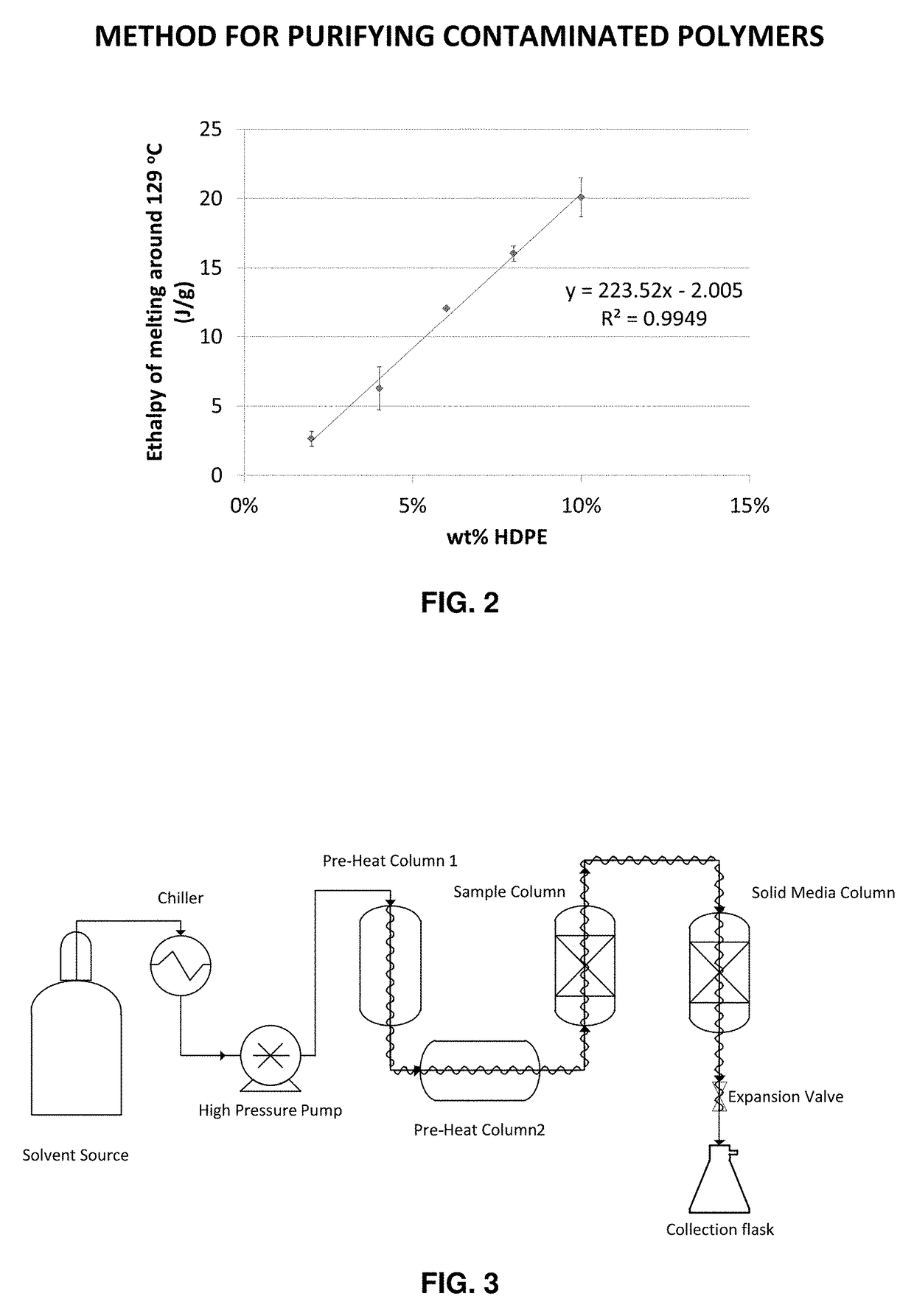Method for purifying contaminated polymers
a polymer and purification technology, applied in the field of purification methods of contaminated polymers, can solve the problems of unsightly and potentially harmful ecosystems, millions of tons of plastic waste generated every year, and the final reprocessed pellet often remains highly contaminated with unwanted waste impurities, such as spoiled food residues and residual perfume components
- Summary
- Abstract
- Description
- Claims
- Application Information
AI Technical Summary
Benefits of technology
Problems solved by technology
Method used
Image
Examples
example 1
[0110]A sample of post-consumer derived recycled polypropylene mixed color flake was sourced from a supplier of recycled resins. The post-consumer recycled polypropylene originated from the United States and Canada. The as-received, mixed-color flake was homogenized via compounding on a Century / W&P ZSK30 twin screw extruder equipped with two 30 mm general purpose screws each with standard mixing and conveying elements. The screw rotation speed was about 50 rpm, the feeder throughput was about 20 lbs / hour (9.07 kg / hour) and the temperature of the barrel ranged from about 210° C. at the die to about 150° C. at the feed throat. The gray strand exiting the extruder was cooled in a room-temperature water bath, dried with air, and chopped into pellets.
[0111]The sample was characterized using the test methods disclosed herein and the resulting data are summarized in Table 1. The purpose of this example is to show the properties of a representative post-consumer derived recycled resin befor...
example 2
[0118]The sample of post-consumer derived recycled polypropylene mixed color flake described in Example 1 was processed using the experimental apparatus shown in FIG. 3 and the following procedure:[0119]1. 225 g of the mixed color flake was loaded into a 1.1 L extraction column pressure vessel with an internal diameter (ID) of 1.75″ (44.45 mm) and a length of 28″ (71.12 cm) that was heated to an external skin temperature of 135° C.[0120]2. Liquid n-butane solvent was pressurized to about 1,000 psig (6.89 MPa) using a positive displacement pump and pre-heated to a temperature of about 90° C. using two heat exchangers before it was introduced to the bottom of the extraction column.[0121]3. The fluid stream leaving the top of the extraction column was introduced into the top of a second 0.5 L pressure vessel with an ID of 2″ (5.08 cm) and a length of about 8.5″ (21.59 cm) that was heated to an external skin temperature of 135° C. The second pressure vessel contained 150 mL of silica ge...
example 3
[0131]The sample of post-consumer derived recycled polypropylene mixed color flake described in Example 1 was purified using a procedure based on the procedure described in EP0849312 A1.
[0132]20.00 g of post-consumer derived recycled polypropylene mixed color flake was combined with 400.04 g of white spirits (Sigma-Aldrich, USA) in a 1 L round-bottomed flask. The mixture was held at room temperature for 22 hours with occasional stirring. The white spirits was then decanted from the polymer. 402.60 g of fresh white spirits was added to the flask containing the polymer. The mixture was then heated and held at 140° C. for 90 min under reflux. The resulting hot solution was vacuum filtered through a 70 mm ID Buchner funnel with a layer of glass wool as the filtration medium. About 300 mL of filtrate was collected and allowed to cool to room temperature. The resulting gray precipitate was isolated via vacuum filtration through a 70 mm ID Buckner funnel with shark skin filter paper. The g...
PUM
| Property | Measurement | Unit |
|---|---|---|
| pressure | aaaaa | aaaaa |
| temperature | aaaaa | aaaaa |
| temperature | aaaaa | aaaaa |
Abstract
Description
Claims
Application Information
 Login to View More
Login to View More - R&D
- Intellectual Property
- Life Sciences
- Materials
- Tech Scout
- Unparalleled Data Quality
- Higher Quality Content
- 60% Fewer Hallucinations
Browse by: Latest US Patents, China's latest patents, Technical Efficacy Thesaurus, Application Domain, Technology Topic, Popular Technical Reports.
© 2025 PatSnap. All rights reserved.Legal|Privacy policy|Modern Slavery Act Transparency Statement|Sitemap|About US| Contact US: help@patsnap.com



